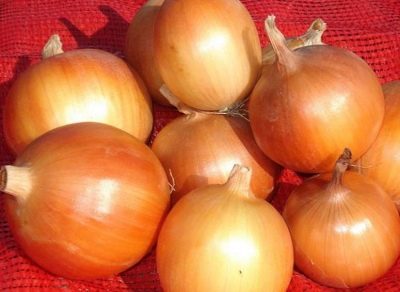
- Name synonyms: Rostovskiy Mestniy
- Year of approval: 1943
- Ripening terms: early maturing
- Bulb weight, g: 30-57
- The form: flat and round-flat
- Dry scales: yellow
- Coloring juicy scales: white
- Density: medium
- Taste: spicy
- Number of arrows : 4-5
Rostov local - a variety that has been used in the agricultural industry for more than a decade. It belongs to frost-resistant species that boast minimal care and high yields. Its maturation rate ranges from 75 to 93%.
Description of the variety
The local Rostov plant has been planted in Russia since 1943. The varietal plant belongs to the onion species. The Rostov local variety has many advantages, for example, it can be transported over long distances, while maintaining the excellent presentation of the heads. Up to 4 bulbs are formed in one nest. Therefore, this variety is referred to as multi-primordial.
Characteristics of the appearance of plants and bulbs
When Rostov local gains green mass, its color is close to saturated green. Arrows are formed in the amount of 4-5 pcs. their height can reach from 70 to 85 cm.
When fully ripe, the heads acquire a flat or round-flat shape. They can be small or medium in size. Usually their weight is from 30 to 57 grams. Dry scales are always yellow, if the head is healthy, and juicy - white. The density of the Rostov local is at an average level.
Purpose and taste
This variety is versatile and suitable for feather or head cultivation. The taste is quite spicy.
Maturation
Early maturing Rostov local ripens from the moment of emergence in 73-93 days, depending on the region of planting.
Yield
The high-yielding variety shows an indicator of 146-320 c / ha.
Growing regions
Rostov local is grown with great success in the Volgo-Vyatka and Central districts, in the North Caucasus and even in Western Siberia.
Growing and care
If onions of this variety are planted in open ground with seeds, then the sowing pattern is 27-30x3-4 cm.When a seed is used as a seed, sow according to a scheme of 0.6-1.0 kg per 10 m2.
Through the set, they grow mainly onions of sharp varieties, to which the Rostov local one belongs. The essence of this method is to constantly maintain the ability of the variety for long-term storage, obtaining an earlier and higher marketable yield in a short growing season.
The seeds of the Rostov local are sown at an early date, which makes it possible to get friendly shoots and grow high-quality seed material without irrigation in almost all soil and climatic zones of Russia. The planting of the Rostov local sevka begins with a small fraction, since it is most resistant to shooting. Use wide-row or tape methods.
Bulbs of Rostov local with a diameter of 0.7-1.4 cm are placed at a distance of 4-6 cm, and 1.5-2.2 cm in size - 6-8 cm.The planting depth is 4-6 cm. seedlings are delayed and the bulbs take on an elongated shape. Sowing is carried out in a tape manner with a distance between the tapes of 50-60 cm, 6-12 holes are made in the tape with a distance of 7.5-15 cm.
Caring for the Rostov local consists in systematic loosening, weed control, and in the southern regions, in dry springs, they provide crops with timely watering.Collect Rostov local at the beginning of feather lodging (5-10%). In years with high humidity, they begin harvesting without waiting for the lodging of the feather, when the bulbs reach an average diameter of 1.0-1.5 cm.

Since the onion is an unpretentious and cold-resistant plant, it can be planted both in spring and autumn. It is necessary to properly prepare the planting material, competently prepare the garden bed and determine the timing of planting.

Soil requirements
Sandy loam soil is best suited for growing Rostov local, where you need to add a decent amount of fertilizer.

The bow is not as unpretentious as it seems. For good growth, you need fertile soil, quality care and nutritious fertilizers. Without top dressing, the bulbs will grow small, and the greens will not be lush. At different stages, it should be fed with different substances. The vegetable needs organic and mineral feeding. A good result for fertilizing onions is the use of folk remedies.
Required climatic conditions
This onion variety has excellent cold resistance.
Disease and pest resistance
Rostov local demonstrates excellent immunity to various diseases, is practically not affected by insects. Relatively resistant to peronosporosis.

Despite the fact that the onion is a very useful plant, capable of repelling and killing many microbes and bacteria, it itself is often damaged and suffers from various misfortunes. Diseases and pests of onions can significantly reduce the yield. It is necessary to correctly determine the presence of this or that disease and take appropriate measures in time.
Review overview
According to agronomists, Rostov local is a good variety for growing both on an industrial scale for feathers and at home in the country. It does not require much care, practically does not get sick. It can rot only in one case - if the soil is heavily waterlogged for a long time.


















































































